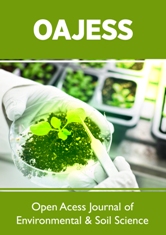
Lupine Publishers Group
Lupine Publishers
Menu
ISSN: 2641-6794
Mini Review2641-6794 
Potential use of wastewater from sewage treatment plants in fertigation in Brazil Volume 5 - Issue 2
Costa Alexandre Sylvio Vieira*
- Department of Environment and water resources, Federal University of Valleys of Jequitinhonha, Brazil
Received: June 01, 2020; Published: June 25, 2020
Corresponding author: Costa, Alexandre Sylvio Vieira, Department of Environment and water resources, Federal University of Valleys of Jequitinhonha, Brazil
DOI: 10.32474/OAJESS.2020.05.000206
Introduction
The volume of fresh water available for human use has
drastically reduced, due to the significant population growth,
intensification of use combined with the effective increase in
pollution and the degradation of water bodies that still exist [1].
Water resource management becomes more sustainable the greater
the use of wastewater. This behavior will contribute to increase the
potential of drinking water, essential to the basic needs of human
beings and to significantly reduce the release of effluents into water
bodies, triggering as an advantage the reduction of pollutants in
the environment and consequent protection of ecosystems Monte
and Albuquerque [2]. According to Ortiz & Pinheiro [3], sewage is a
combination of domestic effluents, industrial waste, effluents from
commercial and institutional establishments, as well as agricultural
effluents. The treatment of effluents generates two by-products,
namely sludge and treated wastewater.
Urban wastewater is subject to variability in its chemical
composition due to its location, the behavior of individuals and
the season, variables that will directly reflect on its quality [4].
Regardless of the chemical variations of the sewage effluents,
after its treatment, its base composition, as described by Costa
[5], comprises the presence of organic matter, mainly resulting
from the wastewater of the toilets and gray water, the result of
the remaining use domestic, inorganic matter, such as salts, acids
and bases, microorganisms and casually metals such as aluminum,
cadmium, lead, chromium. Other compounds present are gaseous
such as oxygen, methane, carbon dioxide and hydrogen sulphide.
The treated effluent, despite going through several treatment
steps, can still contain high levels of nutrients such as nitrogen and
phosphorus. This amount of nutrients can be harmful in a receiving
body of water, increasing its nutrient rates and favoring the growth
of algae and cyanobacteria. However, this type of treated effluent,
with adequate amounts of nitrogen and phosphorus, can be used to
irrigate some crops as fertilizers.
The sanitary sewage treatment operational unit is commonly
called Sewage Treatment Station (ETE), which receives pollutant
sewage loads. The main objective of the ETE is to carry out the
treatment of the effluent, using physical, chemical or biological
processes in order to dispose of waste water treated with a
minimum load of pollutants in the receiving body, reducing possible
environmental impacts and meeting quality standards. required by
law.
Conventional models of agricultural production recommend the
use of mechanization and chemical inputs such as pesticides and
mineral fertilizers, which quickly leads to the degradation of natural
resources [6,7]. In order to increase productivity, it is common to use
chemical fertilizers, which improve the chemical conditions of the
soil by increasing crop productivity. However, these ongoing actions
can promote negative environmental, economic, and social impacts
such as contamination of soil and water and increase production
costs. In view of this problem, a possible alternative for obtaining
fertilizers is the use of wastewater from the Sewage Treatment
Station (ETE) carried out through fertigation. According to Lacerda
et al. [1], fertigation comprises the processes of irrigation and
fertilization, simultaneously. Wastewater is a potential source of
nutrients and organic matter when used in fertigation, contributing
to increased soil activity [8].
Fonseca (2005) mentions that the treated wastewater provided
by the ETE can be used as an alternative source for obtaining
water. This product is also configured, according to its chemical
properties, as a source of nutrients for the soil-plant system, as it
contains macro and micronutrients essential to the development of
plants. In agriculture, the use of treated sewage effluents has been verified, as it enhances greater savings and preservation of fresh
water, reduced costs with fertilizers and increased productivity and
quality of agricultural crops [9]. In this case, the recommendation
is based on the analysis of nutrients needed by the plant, associated
with the supply of nutrients by the soil, through organic residues
and / or by chemical fertilizers [10]. According to Sandri et al. [11],
the use of treated wastewater in agricultural crops is important
not only as an extra source of water, but also due to several other
factors, such as serving as a source of nutrients. The reuse of this
effluent also minimizes the environmental impacts caused by the
disposal in the water body.
According to Gonçalves [12], fertigation with wastewater is the
irrigation process that guarantees greater sustainability through
the application of fertilizers, providing sustainable agriculture and
increasing productivity. In irrigation, treated wastewater must meet
agronomic and public health protection requirements. Designed to
meet the water needs of plants, the water used for irrigation should
not be conducive to substances that may affect its development and
must transport elements that benefit its growth and strengthening.
Of the compounds present in the effluent, those harmful to the
development of crops are the excess of heavy metals, dissolved salts
and sodium. The nitrogenous compounds, phosphorus, potassium,
zinc and sulfur promote the nutrition of the plant submitted to
treated wastewater. Regarding the content of microorganisms
that indicate fecal contamination, public health requests that it be
compatible with the type of exposure, human and animal, to which
the irrigated products will be destined [2].
Studies carried out in the Teofilo Otoni in Minas Gerais, Brazil,
indicate that the wastewater from the sewage treatment station
in that city, in approximately eight hours of fertigation, is able
to supply the needs of pastures (1.0 hectare) with nitrogen and
phosphorus throughout the year
Conclusion
The treated water from the sewage treatment plants that are discharged into even water courses contains significant amounts of mineralized mineral nutrients that can be readily used by plants in fertigation. The development of the logistics of its use in Brazilian crops would be important as it would reduce the use of processed mineral nutrients, reducing the production cost of the crops, considering that 70% of the mineral nutrients consumed in the Brazilian crops are imported. Another point would be the reduction in irrigation of water consumption from sources and water courses that reduce each year in Brazil.
References
- Lacerda PM, Ferreira RR, Arias NJH, Guilherme M, Lima RAS (2011) Influence of irrigation with wastewater on the development of pork beans (Canavaliaensiformis). RevistaAcadêmicaCiênciasAgrárias e Ambientais 9(2): 159-168.
- Monte HM do, Albuquerque A (2010) Wastewater reuse. Lisboa, pp. 319.
- Ortiz, IAS, Pinheiro JHPA (2016) Wastewater: sources, constitution, and treatment technologies. Tupã: ANAP p. 40-57.
- Pina MAG (2010) Characterization of wastewater produced on the university campus of FCT / UNL.Lisboa p.95.
- Costa T (2013) Evaluation of phosphorus and nitrogen contents in a pre-treated domestic liquid effluent in irrigation andAxonopuscompressus. Lajeado pp. 110
- Götsch E (1996) The revival of agriculture. Translate: Patricia (edn), Rio de Janeiro: AS-PTA 2: 24.
- Steenbock W, Silva RS, Frouefe LCM, Seaone CE (2013) Agroforestry and agroforestry systems in space and time. In: Steenbock, W. et al. (Org.); Froufe LCM, Seoane CE (Colab.). Agroforestry, ecology, and society. Curitiba: Kairós 422.
- Oliveira JF, Fia R, Fia FRL, Rodrigues FN, Oliveira FLC and et al., (2019) Effect of dairy waste water on soil basal respiration, productivity and nutrient removal of Tifton 85 (Cynodon sp.). Revista de CiênciasAgrárias 42(1): 155-165.
- Santos GO (2015) Application of sewage treatment effluent, via sprinkling, on the soil and in Brachiaria. Jaboticabalpp. 197.
- Santos FC, Neves JCL, Novais RF, Alvarez VVH, Sediyama CS (2008) Modeling the recommendation of correctives and fertilizers for soybean culture. RevistaBrasileira de Ciência do Solo 32: 1661-1674.
- Sandri D, Matsura EE, Testezlaf R (2007) Development of Elisa lettuce in different wastewater irrigation systems. RevistaBrasileira de EngenhariaAgrícola e Ambiental 11(1): 17-29.
- Gonçalves AA, Moreira CR, Souza GBP, Peres DM, Canzi GM (2019) Fertilizer with sewage sludge in corn. RevistaCientífica do Crea. PR, Edição especial p.1-13.

Top Editors
-

Mark E Smith
Bio chemistry
University of Texas Medical Branch, USA -

Lawrence A Presley
Department of Criminal Justice
Liberty University, USA -

Thomas W Miller
Department of Psychiatry
University of Kentucky, USA -

Gjumrakch Aliev
Department of Medicine
Gally International Biomedical Research & Consulting LLC, USA -

Christopher Bryant
Department of Urbanisation and Agricultural
Montreal university, USA -

Robert William Frare
Oral & Maxillofacial Pathology
New York University, USA -

Rudolph Modesto Navari
Gastroenterology and Hepatology
University of Alabama, UK -

Andrew Hague
Department of Medicine
Universities of Bradford, UK -

George Gregory Buttigieg
Maltese College of Obstetrics and Gynaecology, Europe -

Chen-Hsiung Yeh
Oncology
Circulogene Theranostics, England -
.png)
Emilio Bucio-Carrillo
Radiation Chemistry
National University of Mexico, USA -
.jpg)
Casey J Grenier
Analytical Chemistry
Wentworth Institute of Technology, USA -
Hany Atalah
Minimally Invasive Surgery
Mercer University school of Medicine, USA -

Abu-Hussein Muhamad
Pediatric Dentistry
University of Athens , Greece

The annual scholar awards from Lupine Publishers honor a selected number Read More...




